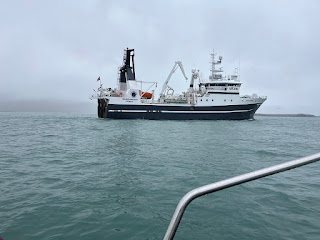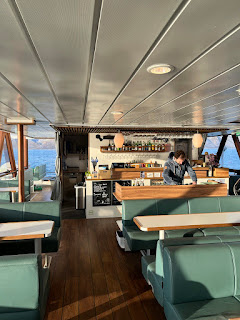Hi, everyone ~!
This is Keito Aonuma. In this article, I'd like to report my stay in Svalbard twice last year! Since the report in IGPEES is approved, I can also write my article here.
Where is Longyearbyen...?
Longyearbyen is a small city located in Svalbard, Norway. Positioned in the High Arctic at 78°13′N, 15°33′E, it is known as the world's northernmost city. While there are other small settlements farther north, they are all temporary and primarily serve research or military purposes.
Svalbard, including Longyearbyen, is a unique place in Norway. The absence of indigenous populations and the late human settlement have contributed to its distinctiveness. Although it is under Norwegian sovereignty, there are no restrictions on foreign economic activities or education. Additionally, while Norway holds sovereignty, some mines are operated by other countries, and until a few years ago, there was even a sushi restaurant run by Japanese sushi shokunins.
Since Longyearbyen is located in the High Arctic, the city experiences long periods of polar night and midnight sun. Both phenomena last for approximately four months, causing significant seasonal variation for the residents. Summer temperatures (in June) are typically in the 10°C range, while the long winter can see temperatures drop to -30°C. Fortunately, being an island surrounded by the sea, it doesn’t get as cold as Siberia.
Another characteristic of Longyearbyen is the risk of encountering polar bears. Despite their seemingly gentle appearance, polar bears are very large and more dangerous than brown bears. As a result, carrying a rifle is mandatory when leaving the city (one rifle per several numbers of people is sufficient, not per person). At UNIS, there is also a rifle course for those taking land routes outside the city for fieldwork.
1st Stay: AB-321 Ecology of Arctic Marine Benthos (2023 Summer)
My first course focused on the benthic ecology of the Arctic. This one-month short-term course was divided into two parts: lectures and a research cruise. The lectures, which lasted approximately ten days, covered oceanography and marine ecology in the Svalbard region. During the nine-day research cruise on R/V Helmer Hanssen, coursemates and I sailed in the Arctic Ocean up to more than 80°N to collect benthic and other marine organisms from Arctic environments.
The lectures were conducted in an omnibus style. Experts from various fields of Arctic study visited UNIS to give classes related to their areas of expertise. Some classes used a traditional lecture format to impart knowledge, while others were interactive. Students were required to read papers in advance and engage in discussions. At times, students had to critique these papers from various perspectives, including methodology, sample settings, figures, and, of course, the discussions and conclusions. It was challenging for me, but I was able to develop a critical mindset.
The research cruise took place in mid-September, covering the west and north coasts of Svalbard. At four or five locations along the route, we collected samples of benthic animals and fish for ecological research. Additionally, we attempted to use ROVs to directly monitor the habitats, but unfortunately, this effort was not as successful as we had hoped. The collected samples were taxonomically analyzed and stored for further research. This process was quite challenging for me, as it involved using numerous identification keys to determine the species of each sample. For a beginner like me, it was demanding, but I managed to catch up.
After the cruise, we completed the remaining taxonomy work and prepared for our presentation and class. The presentation felt somewhat like a defence of our research project, but thanks to the rehearsals with our instructors, it was highly successful.
Additionally, we made another presentation on the sightseeing ship Bird to the public. This was my first experience with outreach. During the preparation process, I had the opportunity to engage in discussions with other students about effective communication strategies, which taught me valuable outreach techniques.
My first course focused on the limnology of the Arctic. This one-month short-term course did not include overnight fieldwork; instead, lectures and fieldwork were conducted concurrently. The course included both land-based fieldwork and snowmobile rides, which required training in rifle shooting and fieldwork operation. I remember successfully hitting the centre of the target during the rifle shooting training. Unfortunately, without a driving license, I was unable to drive the snowmobile and had to settle for riding as a passenger.
The fieldwork for the course was conducted multiple times. The destinations were lakes in the surrounding area, and our goal was to investigate the water quality beneath the frozen lakes during winter. We used a drill to make holes in the thick ice (50 cm to 1 meter) and conducted various tasks, including collecting water and plankton samples and performing CTD measurements. The collected samples were brought back to the laboratory for detailed analysis.
One interesting event during my stay was the Sun Festival! Due to the large mountains on the southern side of Longyearbyen, the city’s first sunrise of the year occurs in early March. This festival was held to celebrate the arrival of the sun after the long polar night!
Summary
My stay at UNIS for just over two months was challenging at times, but it was an incredibly enjoyable experience. Living in dorms with students from around the world—about half from Europe and the rest from the Americas and Asia—was a valuable opportunity for cultural exchange. Building relationships with them will be an asset for the future. UNIS is a fantastic place, and the study abroad process is not cumbersome, so anyone interested in polar regions should definitely consider coming HERE!
------------
I was abroad from August last year until the latter half of April this year, receiving various forms of support during my stay. Below are links to reports detailing my experiences in the different locations I visited:
------------













